20 hp class in the test: Which outboard motor is best suited to your boat?
Ralf Marquard
· 23.12.2024
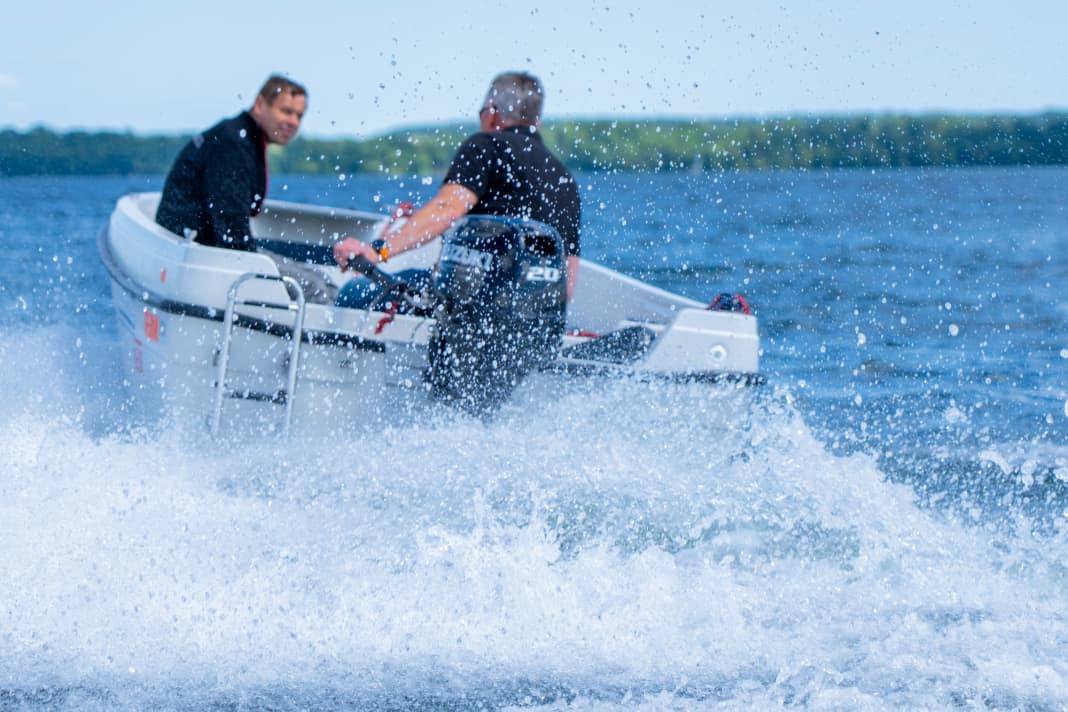





If you want to go boating as cheaply and easily as possible, smaller boats and outboards are a good choice. Dismountable inflatable boats are the ideal companion in motorhomes and can also be easily transported in car trailers. Another option is open sports boats made of aluminium or plastic, for which we recommend a trailer or, if you are not travelling on the road, a slip trailer. Whether for beginners or experienced skippers, this boat-outboard combination can be used for many activities. It is ideal for exploring with the family, swimming or fishing with friends. The corresponding outboard motors can of course be selected individually; if you only want to go out on the lake fishing slowly, you can start with 5 hp or 6 hp manage well. However, if you want to glide with more people on board, you usually need double-digit engine power at the stern.
Our test programme included the 20 hp class with tiller steering from the following manufacturers: Honda, Mercury, Suzuki, Tohatsu and Yamaha. The test boat is a Terhi 450 made of ABS material, which is specified with an unladen weight of 275 kg. With test equipment and two people, we are around 475 kg plus the respective engine weight
If you have to carry the 20 hp engines, pay attention to the weight. With the exception of Yamaha, all test candidates are under 50 kg - the Tohatsu weighs the least. The Yamaha engine has the largest displacement (432 cc) and has an identical brother with 25 hp. The other candidates, on the other hand, are the most powerful models in their series and have less powerful siblings. The displacement of these engines is between 327 ccm and 350 ccm. The combustion chambers of all five engines are divided into two cylinders.
The 20 hp Honda uses proven carburettor technology to prepare the mixture. Its competitors all rely on electronic injection systems that work without batteries and generate the necessary power themselves. If you look at the fuel consumption figures, the Suzuki is most economical when travelling slowly. At fast cruising speeds (25 km/h), the Honda scores 0.18 l/km and is also the most economical at full throttle (36.0 km/h). Mercury, Suzuki and Tohatsu need a tad (0.01 l/km) more at 25 km/h. The Yamaha consumes a little more, but its acceleration is impressive. It takes 7.2 seconds to sprint from a standstill to 25 km/h and takes first place in this discipline. At 62 db/A and 63 db/A, the noise levels measured at idling speed (6 km/h) are almost identical for all test candidates. At full throttle, only the Honda remains at the BOOTE-recommended limit of 85 dB/A. We measured 87 dB/A and 88 dB/A for the Mercury, Suzuki, Tohatsu and Yamaha. All models are below the 85 dB/A limit when travelling at 25 km/h.
With a price of 3790 euros, Suzuki has the cheapest engine on offer, with the Yamaha at the top end at 4465 euros. All engines are also available with an electric starter and remote control, which also makes them interesting for cabin cruising. In order to achieve the recommended full-load speeds, the manufacturers offer a variety of different propellers.
The five outboards in detail
Honda
Honda's BF20 is the only outboard motor with carburettor technology. It is identical in construction to its licence-free 15 hp brother and therefore draws its full power from the 350 cc displacement without throttling. Batteries can be charged with its 12 V/6 A electric generator. The engine has an automatic choke system for cold starts, which makes the petrol-air mixture richer when starting. In addition, a decompression device facilitates the starting process (with the 1.30 m long starting rope and easy-grip knob). The 0.48 m long tiller can be folded upwards by 90 degrees and the twist grip has an imprint for the throttle position and a thick ring with which the friction for the throttle grip can be adjusted. The steering friction - i.e. how hard or easy it is to steer the engine to the left and right - is controlled by a lever near the toggle bolts. The latter have holes to secure the motor against theft. A detailed manual describes the correct use and inspection of the motor. This book also contains information on the warning functions available if the oil pressure is too low or the temperature too high, such as automatic speed reduction. The engine can be trimmed in five positions. In our test, the bolt was in position two. In this position, the engine glided economically and quietly and was also the fastest at 36 km/h.
Technical data
- Manufacturer: Honda
- Type: BF20DK2 LHU
- Cylinder: 2
- cubic capacity: 350 cc
- Performance: 14.7 kW (20 hp)
- Full load speed range: 5000-6000 rpm
- Weight (manufacturer's specification): 49.5 kg
- Recommended fuel: Unleaded petrol
- fuel system: Carburettor
- Ignition: electronic
- Cooling: Water/single circle
- Generator: 6 A
- Recommended mirror height: 563 mm
- Gear ratio: 2,08 : 1
- Gear shift: Manual F-N-R
- Test propeller: 4 x 9 1/4" x 10"
- Acceleration 0-25 km/h: 7.9 seconds
- Manufacturer's warranty: 3 years
- Price: 4139 Euro
- Dealer proof: www.honda.de
Conspicuous
- + Low consumption when gliding
- + fastest motor in the test
- + Quietest engine at full throttle
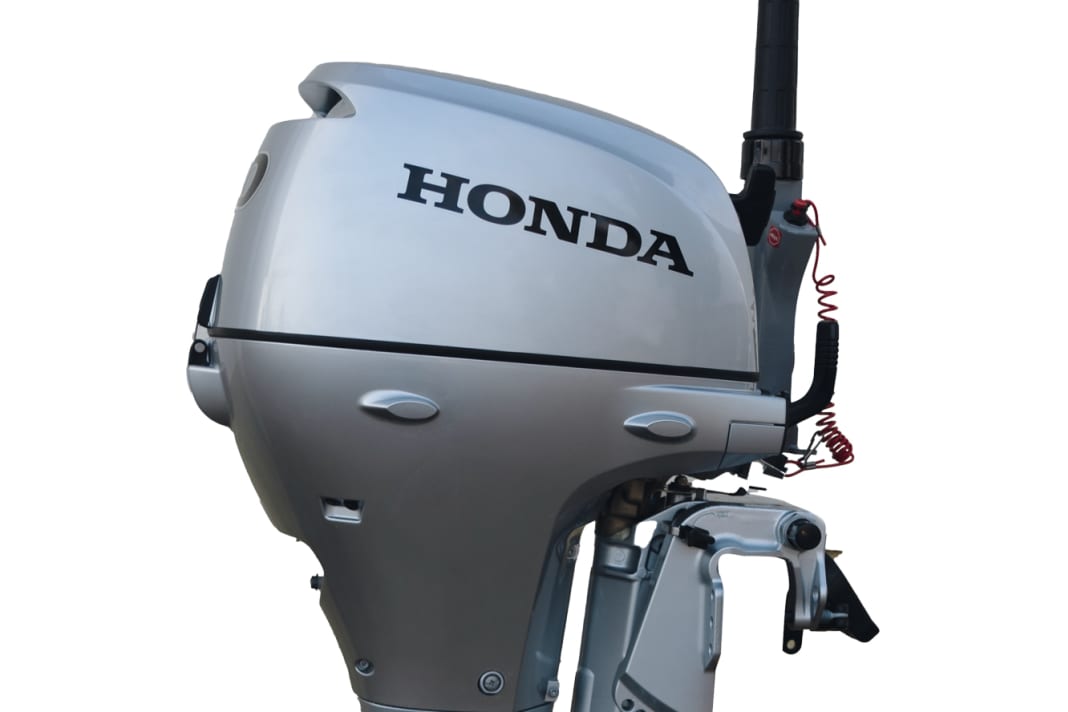





Mercury
The Mercury F20 EFI has a displacement of 333 cubic centimetres, the same as the Tohatsu. This is due to the fact that both engines are technically identical. From the outside, however, the engines are clearly different. The tiller on the Mercury is particularly noticeable, as it can not only be folded upwards, but can also be adjusted laterally by 18 degrees. This means you can always find a good position for optimum operation, and the outboard can be steered easily with both the left and right hand. To ensure that not only the twist throttle (with adjustment for the frictional resistance) is easy to reach, but also the gear lever, Mercury has installed it directly behind the twist throttle. The German-language manual is included in the scope of delivery, as is an emergency start rope. There are six possible positions for trimming the engine; the Mercury technician selected level three for our test. Trimmed in this way, we measured at
25 km/h, which results in a fuel consumption of 4.7 l/h, giving a consumption of 0.19 l/km and a range of 54 km with the 12-litre outboard tank minus 15% reserve. The noise level is then 81 dB/A (lowest value in the test), which increases to 88 dB/A at full throttle at 34.3 km/h. For the price of 4149 euros, the customer receives an engine including propeller, on-board tools and 12-litre outboard tank.
Technical data
- Manufacturer: Mercury
- Type: F20 EFI MLH
- Cylinder: 2
- cubic capacity: 333 cc
- Performance: 14.7 kW (20 hp)
- Full load speed range: 5700-6200 rpm
- Weight (manufacturer's specification): 49 kg
- Fuel: Unleaded petrol
- fuel system: Electronic injection
- Ignition: electronic
- Cooling: Water/single circle
- Generator: 12 A
- Recommended mirror height: 508 mm
- Gear ratio: 2,15 : 1
- Gear shift: Manual F-N-R
- Test propeller: 3 x 9 1/4" x 10"
- Acceleration 0-25 km/h: 7.5 seconds
- Manufacturer's warranty: 2 + 3 years
- Price: 4149 Euro
- Dealer proof: www.mercurymarine.com
Conspicuous
- + Shift lever directly on the tiller with throttle grip
- + Tiller adjustable on both sides
- + Fuel filter with water indicator
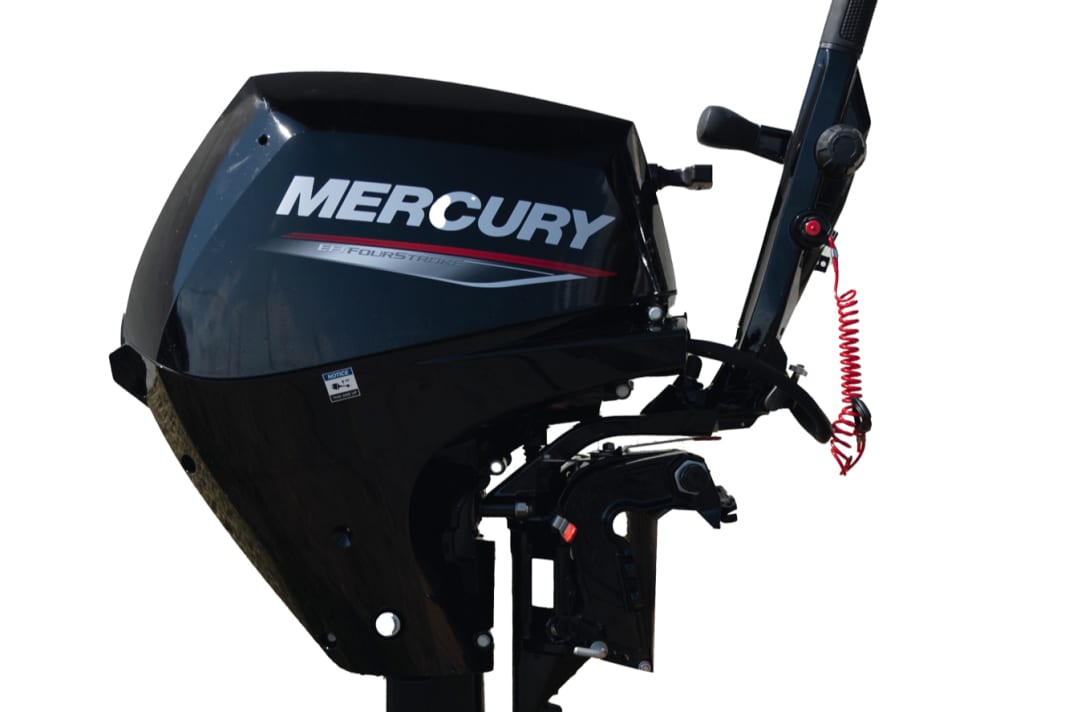





Suzuki
Suzuki is sending its outboard motor with 324 cc and electronic petrol injection into the race. Suzuki calls the latter a "battery-free sequential electronic multi-point fuel injection system". Suzuki were the first with an electronic injection system without a battery in this class. They also equipped their engine with the Suzuki-specific "Lean Burn" system. A 12 V/6 A generator supplies power when required. The identical engine is also available as a licence-free 15 hp version. With a fuel consumption of 0.19 l/km at 25 km/h, it shares places with Mercury and Tohatsu. It is even the most economical when travelling at slow speeds. With a weight of 45 kg, it is at the lower end of the five test candidates. The engine is driven via a folding, 0.45 m long tiller. The twist throttle is easy to operate and a quickstop line ensures safety if the driver falls overboard. The engine is also switched off at the same switch by pressing the button. The cover can be easily removed for maintenance and inspection work. If you then want to change the oil filter, you don't have to replace a cartridge with a metal housing, just a filter insert. It is the cheapest motor in the test and offers a choice of ten propellers for optimum propeller customisation.
Technical data
- Manufacturer: Suzuki
- Type: DF20AL
- Cylinder: 2
- cubic capacity: 327 cc
- Performance: 14.7 kW (20 hp)
- Full load speed range: 5300-6300 rpm
- Weight (manufacturer's specification): 45 kg
- Fuel: Unleaded petrol
- fuel system: Electronic injection
- Ignition: electronic
- Cooling: Water/single circle
- Generator: 6 A
- Recommended mirror height: 508 mm
- Gear ratio: 2,08 : 1
- Gear shift: Manual F-N-R
- Test propeller: 3 x 9 1/4 "x 10"
- Acceleration 0-25 km/h: 8.2 seconds
- Manufacturer's warranty: 5 years
- Price: 3790 Euro
- Dealer proof: www.marine.suzuki.de
Conspicuous
- + most favourable motor in the test
- + is available in the colours black and white
- + Fuel filter with water level indicator
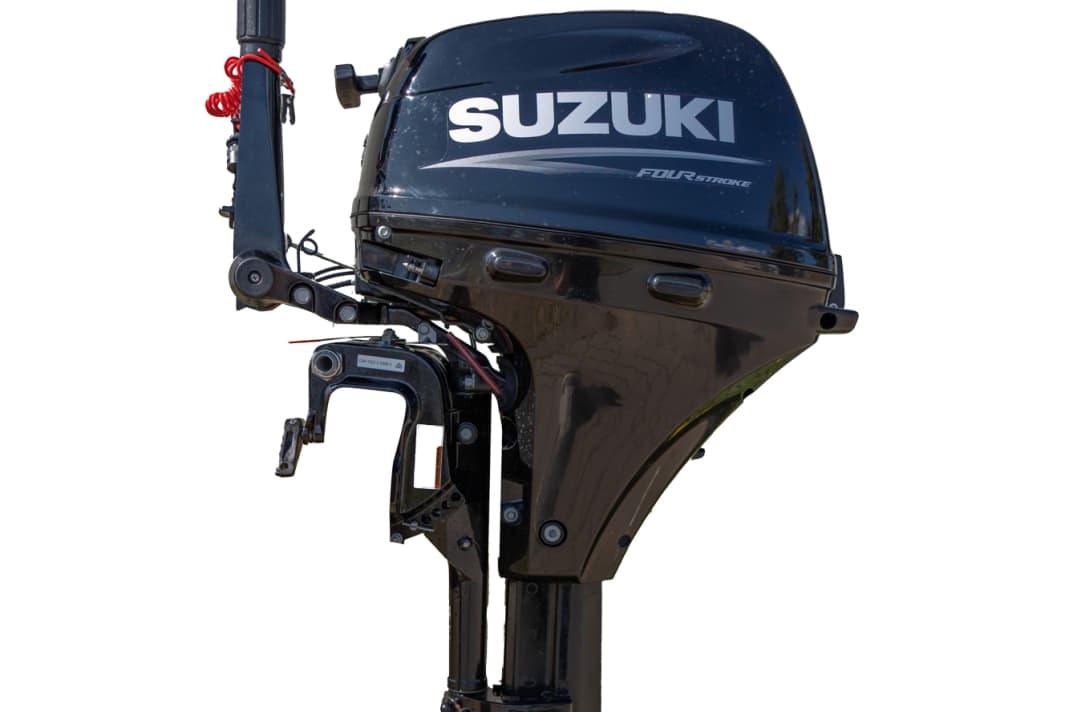





Tohatsu
As already mentioned, it has the same technology under the bonnet as the Mercury. However, there is a clear difference in the look of the bonnet - the Tohatsu is also available in the colours white and black. The tiller has a length of 0.42 metres and a twist throttle with an adjustment screw for the frictional resistance. The gear lever is located at the height of the tiller attachment. An easily accessible fuel filter with water separator and corresponding control ring can be found under the easily removable canopy. The fuel is fed to the electronically controlled injection nozzles by two petrol pumps connected in series. Safety system: In the event of oil or temperature problems, the engine speed is automatically reduced. There is a locking device to ensure that the engine cannot be started accidentally with a gear engaged. A quick-stop switch with a cord and clip takes over the emergency stop function if the driver is involuntarily "pushed" from his seat. The normal switch-off button is also located on the quick-stop device. The measured values are in the medium range, such as fuel consumption at 25 km/h with 0.19 l/km and 0.20 l/km at full throttle. The noise level at full throttle is 87 dB/A (second best value) and at 25 km/h 82 dB/A. At 44 kg, it was the lightest outboard in our test. At 4159 euros, the price is in the mid-range.
Technical data
- Manufacturer: Tohatsu
- Type: MFS20E L
- Cylinder: 2
- cubic capacity: 333 cc
- Performance: 14.7 kW (20 hp)
- Full load speed range: 5400-6100 rpm
- Weight (manufacturer's specification): 44 kg
- Fuel: Unleaded petrol
- fuel system: Electronic injection
- Ignition: electronic
- Cooling: Water/single circle
- Generator: optional 12 A
- Recommended mirror height: 562 mm
- Gear ratio: 2,15 : 1
- Gear shift: Manual F-N-R
- Test propeller: 3 x 9 1/4 "x 10"
- Acceleration 0-25 km/h: 7.8 seconds
- Guarantee (Marx): 5 years
- Price: 4159 Euro
- Dealer proof: www.tohatsu.de
Conspicuous
- + lightest motor in the test
- + available in two colours
- + Fuel filter with water level indicator
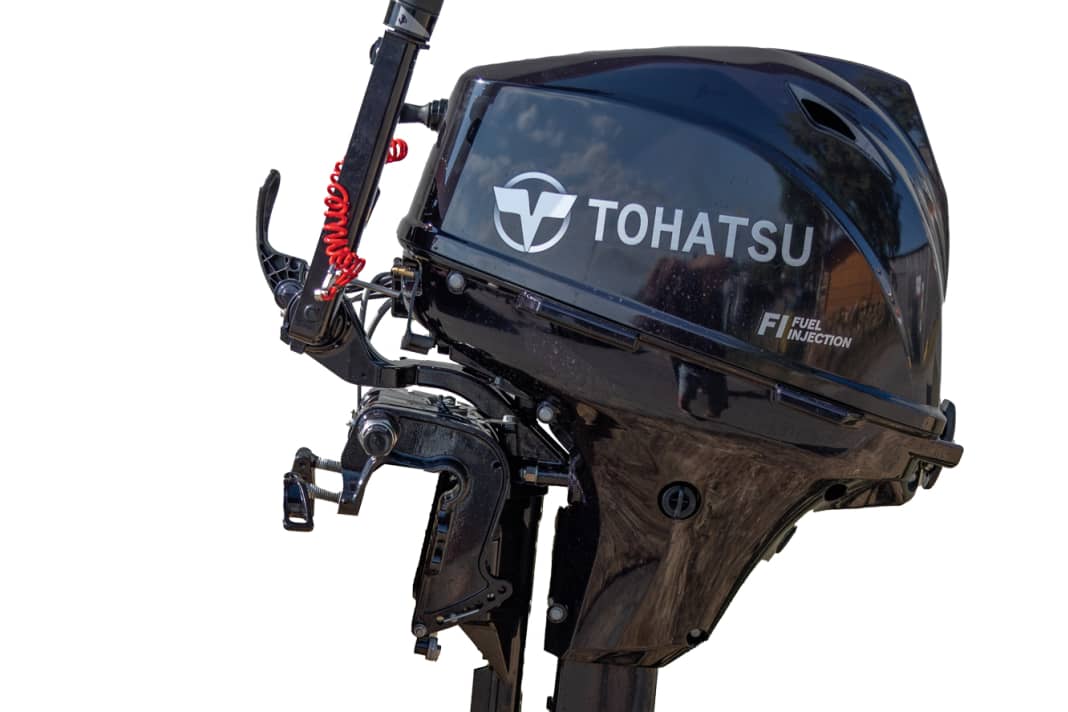





Yamaha
Yamaha's F20 has the largest displacement of all the test candidates. It also has a big brother with 25 hp, which belongs to the same series. With its weight of 59 kg, it is also the heaviest model. In terms of acceleration, it takes first place with 7.2 seconds (0-25 km/h). This value is a good prerequisite for the engine to propel even heavy boats with the appropriate propeller without any problems. With our test Terhi-450, you have to allow for slightly higher consumption when gliding. At 62 dB/A, the noise levels are at
6 km/h and at full throttle (34.3 km/h) at 88 dB/A, on a par with Mercury and Suzuki. Our Yamaha test model is started with the aid of a 1.45 m long cable and easy-to-grip toggle. The model can only be started when the easily accessible gear lever on the 0.50 m long tiller is in neutral. According to Yamaha, the tried-and-tested PrimeStartTM together with the new battery-free EFI system ensures that the engine starts well even in cold temperatures. In our test, the engine always started without any problems. An emergency start is also possible. The engine is trimmed using a bolt that can be set in four positions, with two shallow water positions also available. The motor is bolted to the transom with solid toggle bolts. A control system protects the motor in the event of technical problems.
Technical data
- Manufacturer: Yamaha
- Type: F20G MHL
- Cylinder: 2
- cubic capacity: 432 cc
- Performance: 14.7 kW (20 hp)
- Full load speed range: 5000-6000 rpm
- Weight (manufacturer's specification): 59 kg
- Fuel: Petrol
- fuel system: Electronic injection
- Ignition: electronic
- Cooling: Water/single circle
- Generator: 16 A
- Recommended mirror height: 551 mm
- Gear ratio: 2,08 : 1
- Gear shift: Manual F-N-R
- Test propeller: 3 x 9 7/8" x 9"
- Acceleration 0-25 km/h: 7.2 seconds
- Manufacturer's warranty: 3 years
- Price: 4465 Euro
- Dealer proof: www.yamaha-motor.eu
Conspicuous
- + best acceleration
- + with 24-litre tank as standard
- + charging coil with 16 A
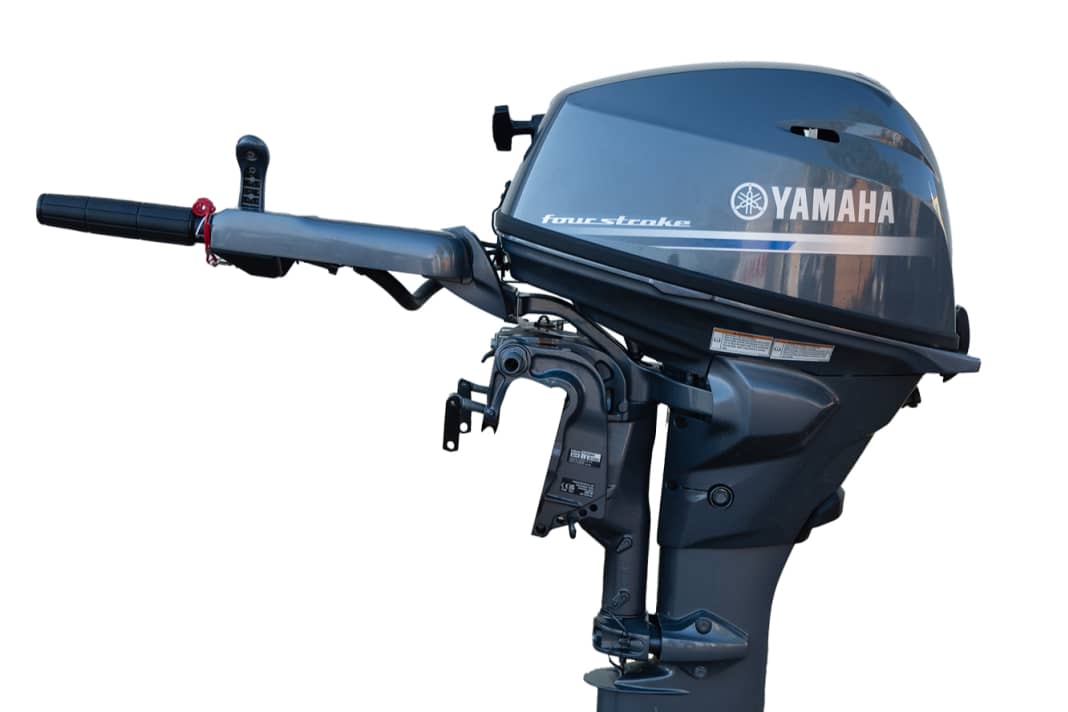





Conclusion on the outboard motor test
Honda is first in terms of top speed and has the most favourable fuel consumption figures when gliding, as well as a low noise level at full throttle. The Yamaha shows its strength when it comes to power from below. The Mercury is the quietest at 25 km/h and has the second-best sprint time, while the Tohatsu weighs the least and is in second place for full throttle noise. The Suzuki DF20 is the clear winner in terms of price, as it has low fuel consumption at low speeds. However, we recommend not only looking at the figures when making your choice, but also looking for a good service centre nearby.

